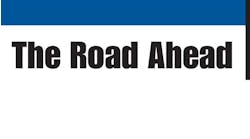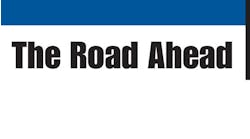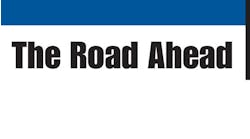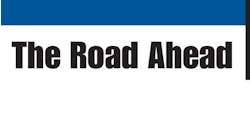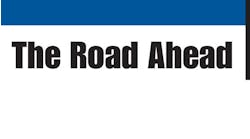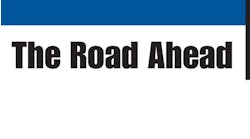MORE THAN 1,700 aftermarket industry leaders got a glimpse of what the future may hold for the aftermarket during the sixth annual Heavy-Duty Aftermarket Week held in Las Vegas, NV, January 17-20, 2011.
The event attracted more than 1,400 people. The following pages present a sample of what they saw:
AS it turned out, moderator David Scheer didn't have to do much moderating in “OEM Dealers Versus Heavy-Duty Distributors: Point-Counterpoint.” And he certainly didn't have to spring into action as some sort of pseudo-referee.
This was not The Jerry Springer Show. Or a Bill O'Reilly interview.
The few fireworks that erupted didn't really come until the very end, when Michele Calbi, vice-president of parts for Navistar Defense, and Marc Karon, president of Total Truck Parts, were asked:
Why would a truck manufacturer restrict access to technology and product information necessary to service the customer, artificially placing a barrier for the distributor?
Calbi, given the first opportunity to respond, said it's “a very heated emotional issue” and there were no “simple” answers.
“And it's not just the OE and the distributor,” said Calbi, who joined Navistar after serving as vice-president of procurement and shop operations for Swift Transportation. “In my mind, that's a simplification of what's going on. You have to start with the supplier. The supplier spends a lot of money in R&D to develop products. If you look at the millions they spend in R&D, they want to have control over where products and technology go. So they manage that in a particular manner with the OE and truck world, and with the distributor in how they go about the marketplace.
“Then you move to the OE. The OE spends millions. You can't even imagine what it costs these OEs just to get where they need to go to meet standards. Then you move to the next level, which is the dealer. The dealer has huge overhead and facilities to facilitate. They have to have flooring, which is hugely expensive when trucks aren't moving and they aren't making money on truck sales.
“Then you look at the customer and fleets such as Swift. I can tell you we didn't want our trucks spec'd anywhere. To us, that was our competitive advantage. We saved fuel with our truck specs and we were careful with how those trucks were managed. The dealer network knew they had to be confidential with how our trucks were set up.
“Then you move to the distributor. Distributors are extremely important to that customer, owner, and the guys that really need to be careful on how they spend their money. When you look at the food chain, this isn't a free lunch. You have to look at every level. And you have to look at the customer. There are a lot of owner-operators that don't want their specs out. They take pride in how they set up the truck. So it's not up to the OE to be able to release that information overall. It does become an emotional issue on all different levels. It's not a simple answer. And it's not going to be decided here.”
No, but Karon had to offer his counterpoint. And he didn't waste any time.
“I see that the OEs spend millions of dollars, suppliers spend millions of dollars, the dealer has overhead and the only way he can survive is to charge more than the market price would be if the information was more available,” he said. “Fleets that have proprietary information can deal with whatever they want to whenever they want to. There are certain ways to control that (information).
“It's all about how much you can charge. If you're the only guy that has the part or the repair book, you can charge whatever you want for it. And I don't believe that you ever have a situation, unless you have a patent or trademark protection, where you should be able to protect something that isn't really yours. The guy who buys the truck owns the truck. Can you imagine buying a house and having to call the contractor to have a light bulb changed because he has all this money invested in building your house? I think when you buy something, you own it and should have the right to decide where you're going to get it repaired.”
Here's what Calbi and Karon had to say about other issues:
Q: Is the marketplace well-served by having two channels — the OE channel and independent distribution channel?
Calbi: “I think that the marketplace makes that decision. If there is business and it's profitable and they're treating customers right, the marketplace will always determine that. I'm a big believer in open competition. The best company wins the customers. I think it's extremely important that customers have choices — that's what America is all about — and we facilitate that. When you see certain businesses fail because they won't change, they haven't met what the marketplace or what the customer has demanded.”
Karon: “The market is well-served by having two channels. If they are on equal planes, they compete. And when they compete, they try to improve all aspects of their business. Continuous improvement is a precursor to success. So by having competition, we're all becoming better. And because we're becoming better, we're servicing the customers better. But an important part of the two-channel strategy has to be price parity, because when there's price disparity in the market, then one channel employs predatory practices to go after a business. The whole focus shifts to price and away from service. The customer wants service. Most of the surveys I've seen say price is important, but not the only thing customers want.”
Calbi: “It depends on where you sit. If you're sitting on one side, you say, ‘Ah, they're just so aggressive with pricing.’ If you're sitting on the distributor side, it, ‘They're killing us with pricing.’ A supplier … I can imagine they're in a predicament where they can never win because they're getting it from both sides. The beauty of it all is being as efficient as you can — be smart enough to buy at a level that necessitates being competitive and keeping up with what's happening with the economy. This is a good time to make changes. Price, when we survey customers, is not always the No. 1 issue. You can have a rock-bottom price on a part but not have availability, so what good is that price?”
Q: Do you think there is price parity at the street level for the distributor and dealer?
Calbi: “No, I don't. The pricing depends on a supplier's strategy. The filter company handles their pricing strategy better than a bearing company. So comparing pricing, you can get into some issues of antitrust. The competition bears down on how good a facility can keep costs under control. If you look at Six Sigma and 5s, if you don't know what those are and aren't employing them in your business, that's exactly what you should be doing. Commodities are going to move — they're going to go up — so that one competitive factor isn't going to be the price you get from the supplier. It's how effective you are at keeping costs under control.”
Q: Is parity channel-driven or supplier-driven?
Calbi: “I think it's both. You have suppliers who have their own strategies on how they price and how they manage their different parts and channels. You can talk to different suppliers, and they have different strategies depending on how they want to go after the market and penetrate it as effectively as they possibly can.”
Karon: “I think there is a danger in the fact that the supplier does not sell to the dealer. Sometimes they say, ‘Hey, it's not your fault. I sell them the price they're supposed to sell to dealers to compete at the same price as you, but they don't.’ I think suppliers have to pay more attention to price in the market. It's to their interest that there be price parity in the market. For the most part, there is with major suppliers. But one area where it's not — it just seems that every time there is a price increase, the OE dealer tends to lag the distributor by two to three months. Whether that's sloppy accounting on the OE side — which is what the supplier tells us — or whether the supplier is winking and smiling and letting them get away with it, I don't know. But that's an issue that creates havoc in the market, especially when you get double-digit price increases, especially with what we're seeing now with commodities.”
Q: What are strengths and weaknesses of the OEM dealer?
Karon: Multiple profit centers. The typical dealer sells new trucks and used trucks, has a warranty department, a shop and parts department, financing, and leasing. He has all these different profit centers and one overhead. So how they allocate their costs to absorbing that overhead makes a big difference to how they set pricing strategies in the market. Because they have multiple profit centers, in some cases they set break-even margins a lot lower than a single parts distributor would. So some of the dealers say, ‘I'm making a fortune at 20% gross profit.’ I don't know any independent that's making a fortune at 20% gross profit. So that creates some of the price advantage in the market. Dealers also have access to every single brand that goes on that truck. They don't have to jump over hurdles to buy so much to get access. That's a big advantage. The OEMs are very powerful and motivated to bring in national fleet business so they direct it back to dealers. They have access to all these proprietary parts, and the fact that they have proprietary information makes it easier for them to effect a sale, because they can go to the VIN code to the part.
“There are a lot of disadvantages: They tend to lack coverage and depth in all makes of products. They focus more on their nameplates. And they tend to not have the best people in the market, which is think is very important. They don't work very well with suppliers. Their suppliers don't have the strong relationships that can be necessary when you talk about the independent dealer. They have OE control in some aspects of their business, which means that they sometimes have a more restrictive warranty policy, and the OE can mandate certain requirements from facilities and how they're structured. That may not be beneficial to their particular market. They're very slow to bring new products to market. They tend to sell what went on the trucks. They have a limited number of shop bays, so since they have to take care of warranties first, in some cases they can't give the level of service to customers that the independent can.”
Calbi: “It's always quite amusing to have one side of the fence and hear comments from other side. Having been very close to dealers in my career and been in dealer council meetings, they're always saying, ‘Our overhead is huge. It's very difficult to be profitable. Our margins are too low on parts.’ It's just so interesting, the dichotomy of it all. Marc is right: There are a lot of areas in which they can make profit. However, if you think a dealer is making profit in the new truck department the last few years, I don't think so. The used truck department has been extremely difficult. So they have to make sure their service and parts business absolutely covers the dealership. And if they don't have absorption, they are going to lose position every single month. It is extremely difficult in this environment — you look at some of the megadealers that are trying to survive when they have big facilities and a large amount of bays.
“But on positive side, I was with Swift when there was a network of dealers we could depend on, and we knew that we had a connection to a great dealer network that could keep our truck running, and they could call ahead and set an appointment. We could absolutely maximize our truck, and that is extremely important. You've heard of all the challenges they have from HOS to all diff regulations coming in. It is an ext difficult environment, so no matter whether that fleet lands in a facility that is a distributor or is a dealer, you've got to keep them alive. That network is something we looked at and we paid attention to. That is an absolute strength when it comes to certain OEs. Certain OEMs have a stronger supply chain than others as far as the dealer network is concerned. There are a lot of master technicians in a dealer network. There are emissions standards, and they have laptops and are trying to diagnose. It is becoming very difficult. That's where the magic lands with a technician being able to diagnose quickly, turn that truck around quickly, and get it back on road.
“I firmly believe that the dealer network has more strengths than weaknesses. It depends on how sophisticated that dealer is. It depends on how dedicated they are to learn to train to be an effective dealer. There are really good ones and some that are not so good. That's the same thing in the distributor network as well.”
Karon: “She brings up two important points. We've got to figure out a way to come together — marketing groups or whatever — and build that network so when that truck leaves West Palm Beach and goes to wherever, it gets everything the same that it gets in West Palm Beach. This national fleet issue is something we talked about, and I think it's a weakness in our side of the industry. The second thing is training. We've got to work on it. Trucks are changing dramatically, and if we're still doing the same things we did five years ago, we're falling behind. And if we continue to fall behind, we're going to be left out.”
Q: Key weaknesses of the independent distributor?
Calbi: “There are highly sophisticated, very professional distributors such as Dave (Scheer). I'm very familiar with the distributor network. It's good for the marketplace to have good, professional competitors. It's extremely important that the trucking industry be seen in a positive light. It's extremely important that we all make sure we do that day to day in our businesses. The weakness is the network. If you want to strengthen it and have a NAFTA network … and I'm not just saying it needs to just be the US. Canada needs to be in there. The dealer network in Canada is one heckuva dealer network. It's extremely important to stay up on technology, because it's moving so fast. You have to decide what niche you want to be in, and you need to be very good at whatever niche that is — drivetrain or DEF or reman or rebuild. You want to be the best you can possibly be. That reputation is extremely important.
“A soft spot that is very embarrassing for the industry is what happened in Oregon with Kustom Trucks. They were selling parts and representing them as OE parts, and they were knockouts. The FBI came in and cleaned house. If any of you are doing any of that, that is very bad. Please represent your parts exactly for what they are. You're putting that driver and others at risk. I challenge you to look at that example, because there will be more. That leads unfortunately through the distributor network, so that would be a negative that needs to be cleaned up.”
Karon: “I agree with everything she said. One addition: We're going to have trouble servicing some of the newer-model trucks. It's more difficult for us at certain times servicing the customer because he can't call up and say, ‘Here's my VIN number, I need this.’ We don't have the ease of going into the computer and finding the part.”
Q: Who does a better job of partnering with repair shops?
Karon: “I think the independent distributor does have an advantage over the dealer in rapid-response delivery systems. If repair shops need parts right away, we've built our businesses on being able to get that part out the door. Dealers have more route-delivery systems and can't run that hotshot delivery like we can.”
Calbi: “More sophisticated dealers are on the phone servicing repair shops. I'll name one: Freightliner. They are highly sophisticated. They make sure they put their hand on the part, especially if they know it's an urgent situation. That's a company to benchmark if you're looking at servicing and urgency. There are a couple of Navistar dealers as well. These dealers get it. They're unbelievable at reading catalogs and knowing what they need to get that customer right away, and they don't have routes. They are hotshot, and they make it happen. Certainly there are quite a number of sophisticated dealers who dedicate people, time, and delivery vehicles specifically to repair shops and hotshot.”
Karon: “I think you are correct. There are very good dealers out there who are changing the way they do business. They learned how to service the customer from a distributor perspective, if I can call it that. I think the same is true on the independent side. If you want to be a success in the future, you have to provide a level of service the customer wants, and no longer just focus on price.”
